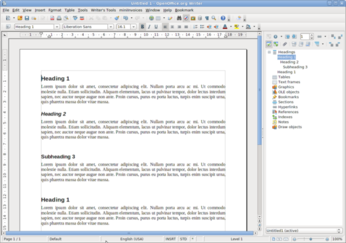Using OpenOffice.org as an Outliner

Productivity Sauce
Although OpenOffice.org Writer can't replace a dedicated outlining application, there are two ways to turn the word processor into a lightweight outliner. The easiest one is to press the Numbering On/Off button in the main toolbar or the F12 key. This turns the current line in the documents into a numbered entry and displays the Bullets and Numbering context toolbar which offers basic outlining tools. The Promote, Demote, Move Up and Move Down buttons in the toolbar allow you to easily rearrange outline entries, while Bullet and Numbering opens the dialog window which lets you tweak different settings such as Numbering type, Outline, Position, etc. You can also create a custom outlining style or modify an existing one using Stylist. Press F11 to evoke the Stylist panel, switch to the List Styles section, right-click then on the style you want to edit and choose Modify from the context menu. If you want to create a new style from scratch, choose the New item from the same context menu or press Shift+F11.
Another approach requires a bit more work, but it allows you to use OpenOffice.org Writer as a two-pane outliner. This solution is based on the Outline Numbering feature which lets you specify a hierarchy of heading styles and then manage them using the Navigator. By default, OpenOffice.org Writer uses the built-in heading styles (i.e., Heading 1, Heading 2, Heading 3, etc.) for each level, but you can easily change that using the Tools -> Outline Numbering dialog window.
Using heading styles to structure your outline is easy: apply the Heading 1 style to the top level of your outline and other heading styles to sub-levels, for example:
Primates (Heading 1) Monkeys (Heading 2) Capuchins (Heading 3) Japanese snow monkeys (Heading 3)
The fastest way to apply styles is to use keyboard shortcuts: Ctrl+1 for Heading 1, Ctrl+2 for Heading 2, and so on. To make Writer look like a more conventional two-pane outliner, open the Navigator panel (press F5 or choose View -> Navigator) and dock it to the right or left of the main window. To do this, drag Navigator close to the right or left side of the screen, and release the mouse button when you see a gray window outline. In the Navigator panel, expand the Headings section, and you should see the outline as a hierarchical tree containing the specified headings:
Primates
Monkeys
Capuchins
Japanese snow monkeys
You can quickly navigate to a specific heading by double-clicking on it in the Navigator. But that's not all: the Navigator also offers four buttons that allow you to promote and demote levels as well as move them up and down. Using these buttons, you can rearrange your outline and move headings around as you would in a traditional outliner.
Comments
comments powered by DisqusSubscribe to our Linux Newsletters
Find Linux and Open Source Jobs
Subscribe to our ADMIN Newsletters
Support Our Work
Linux Magazine content is made possible with support from readers like you. Please consider contributing when you’ve found an article to be beneficial.

News
-
Parrot OS Switches to KDE Plasma Desktop
Yet another distro is making the move to the KDE Plasma desktop.
-
TUXEDO Announces Gemini 17
TUXEDO Computers has released the fourth generation of its Gemini laptop with plenty of updates.
-
Two New Distros Adopt Enlightenment
MX Moksha and AV Linux 25 join ranks with Bodhi Linux and embrace the Enlightenment desktop.
-
Solus Linux 4.8 Removes Python 2
Solus Linux 4.8 has been released with the latest Linux kernel, updated desktops, and a key removal.
-
Zorin OS 18 Hits over a Million Downloads
If you doubt Linux isn't gaining popularity, you only have to look at Zorin OS's download numbers.
-
TUXEDO Computers Scraps Snapdragon X1E-Based Laptop
Due to issues with a Snapdragon CPU, TUXEDO Computers has cancelled its plans to release a laptop based on this elite hardware.
-
Debian Unleashes Debian Libre Live
Debian Libre Live keeps your machine free of proprietary software.
-
Valve Announces Pending Release of Steam Machine
Shout it to the heavens: Steam Machine, powered by Linux, is set to arrive in 2026.
-
Happy Birthday, ADMIN Magazine!
ADMIN is celebrating its 15th anniversary with issue #90.
-
Another Linux Malware Discovered
Russian hackers use Hyper-V to hide malware within Linux virtual machines.


Try LyX for good outliner capability in a document processor
Would be great if it worked
This is of course bugs, and nothing but bugs. I could report them, but it's not worth the hassle. Reporting bugs to Open Office is difficult, and bug-fixing is so slow that KOffice 2 will be a better replacement long before they ever fixed the bug. It's a pity, but I've lost all hope that OO.o will ever be anything but secondary to MS Office.
How Not To Shorten URLs
> You can shorten the URL [via http://tinyurl.com/] yourself before you share it.
A bad idea. URLs transport some inherent meaning other than just a way of delivering content. And TinyURL is but a redirection service, therefore, it just adds another level of complexity (another point of failure) to internet addressing.
Firstly, there's a difference between the domain tinyurl.com and example.com (replace "example" with some bad malware site). I prefer to see the proper domain name.
Secondly, they proudly state:
> we will create a tiny URL that will not break in email postings and never expires.
A bold promise! But still, their URLs are not the real ones. If TinyURL ceases to exist, they will not be bound to their promise anymore. (And they are not bound to it, anyway.) And if the original URL or domain ceases to exist, there will possibly no way for the average user to find the tiniest hint on what the original page was about. (For moderate hackers, there may be some hints in their HTTP headers, but Joe the Average Plumber will neither be able to find, nor to understand these headers.)
Therefore, I'd say that TinyURL is inherently bad. http://tinyurl.com/ is in every respect one of the worst websites ever created.
To shorten URLs is the alone obligation of the original website.
Please . . . you haven't tried org-mode yet
sincerely,
a former vi-ninja-cum-emacs-pirate
shortening urls
You can shorten the URL yourself before you share it.
Dmitri is great, long URLs are insane!
And Dmitri, thanks for another great article. I always look for yours because they are so good.